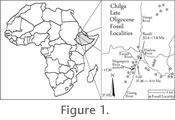Geological setting
 The study area is part of a series of terrestrial deposits that form an informal lithostratigraphic unit named Chilga strata (or Chilga beds). These strata are located 60 km west-southwest of Gondar on the northwestern Ethiopian Plateau (Figure 1). The Chilga beds (~100 km2) consist of a succession (up to 150 m thick) of volcaniclastic sediments and paleosols intercalated with volcanic deposits (Feseha 2005;
Jacobs et al. 2005). These strata overlie a plateau of massive flood basalts extruded during Oligocene volcanism (Yemane et al. 1987a;
Jacobs et al. 2005;
Hoffman et al. 1997). A K-Ar radiometric age of 32.4 ±1.6 Ma was obtained from basalt that directly underlies the Chilga sedimentary strata (Figure 1,) (Kappelman et al. 2003).
The study area is part of a series of terrestrial deposits that form an informal lithostratigraphic unit named Chilga strata (or Chilga beds). These strata are located 60 km west-southwest of Gondar on the northwestern Ethiopian Plateau (Figure 1). The Chilga beds (~100 km2) consist of a succession (up to 150 m thick) of volcaniclastic sediments and paleosols intercalated with volcanic deposits (Feseha 2005;
Jacobs et al. 2005). These strata overlie a plateau of massive flood basalts extruded during Oligocene volcanism (Yemane et al. 1987a;
Jacobs et al. 2005;
Hoffman et al. 1997). A K-Ar radiometric age of 32.4 ±1.6 Ma was obtained from basalt that directly underlies the Chilga sedimentary strata (Figure 1,) (Kappelman et al. 2003).
 The Ash-IV sequence occurs stratigraphically above the dated basalt and is the thickest (up to 20 m) and the least weathered of the tuff sequences in Chilga. This tuff sequence has been used as a guide to correlate sedimentary units laterally across the basin, and contains abundant plant macrofossils (García Massini et al. 2006). An 40Ar/39Ar age of 27.36 ± 0.11 Ma was obtained from the Ash-IV sequence itself where it is exposed along the margins of the Guang River (Figure 1,) (Kappelman et al. 2003). Sections of Ash-IV and of the thin set of volcaniclastic strata immediately below are exposed along the margins of the Margargaria River (12° 30' 31.3'', E 37° 6' 57.3'') and are the subject of this paper (Figure 1,
Figure 2).
The Ash-IV sequence occurs stratigraphically above the dated basalt and is the thickest (up to 20 m) and the least weathered of the tuff sequences in Chilga. This tuff sequence has been used as a guide to correlate sedimentary units laterally across the basin, and contains abundant plant macrofossils (García Massini et al. 2006). An 40Ar/39Ar age of 27.36 ± 0.11 Ma was obtained from the Ash-IV sequence itself where it is exposed along the margins of the Guang River (Figure 1,) (Kappelman et al. 2003). Sections of Ash-IV and of the thin set of volcaniclastic strata immediately below are exposed along the margins of the Margargaria River (12° 30' 31.3'', E 37° 6' 57.3'') and are the subject of this paper (Figure 1,
Figure 2).